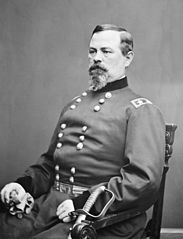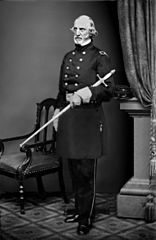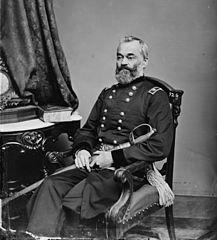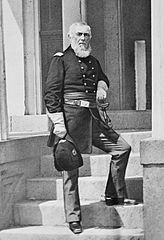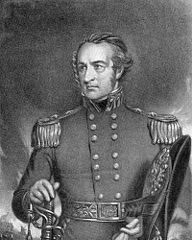A | B | C | D | E | F | G | H | CH | I | J | K | L | M | N | O | P | Q | R | S | T | U | V | W | X | Y | Z | 0 | 1 | 2 | 3 | 4 | 5 | 6 | 7 | 8 | 9
| First Battle of Bull Run Battle of First Manassas[1] | |||||||
|---|---|---|---|---|---|---|---|
| Part of the American Civil War | |||||||
 Struggle on a Manassas, Virginia bridge during the Union Army's retreat in 1861 depicted in an engraving by William Ridgway based on a drawing by F. O. C. Darley | |||||||
| |||||||
| Belligerents | |||||||
|
|
| ||||||
| Commanders and leaders | |||||||
| Irvin McDowell |
Joseph E. Johnston P. G. T. Beauregard | ||||||
| Units involved | |||||||
|
Department of Northeastern Virginia:
| Army of the Shenandoah[4] | ||||||
| Strength | |||||||
|
Army of Northeastern Virginia: Patterson's Command:
|
32,000–34,000[7] (c. 18,000 engaged)[6] | ||||||
| Casualties and losses | |||||||
|
2,708 481 killed 1,011 wounded 1,216 missing[8][9] |
1,982 387 killed 1,582 wounded 13 missing[10][11] | ||||||


The First Battle of Bull Run, called the Battle of First Manassas[1] by Confederate forces, was the first major battle of the American Civil War. The battle was fought on July 21, 1861, in Prince William County, Virginia, just north of what is now the city of Manassas and about thirty miles west-southwest of Washington, D.C. The Union Army was slow in positioning themselves, allowing Confederate reinforcements time to arrive by rail. Each side had about 18,000 poorly trained and poorly led troops. The battle was a Confederate victory and was followed by a disorganized post-battle retreat of the Union forces.
Just months after the start of the war at Fort Sumter, the northern public clamored for a march against the Confederate capital of Richmond, Virginia, which was expected to bring an early end to the Confederacy. Yielding to political pressure, Brigadier General Irvin McDowell led his unseasoned Union Army across Bull Run against the equally inexperienced Confederate Army of Brigadier General P. G. T. Beauregard, whose forces were camped near Manassas Junction. McDowell's ambitious plan for a surprise flank attack on the Confederate left was poorly executed although the Confederates, who had been planning to attack the Union left flank, found themselves at an initial disadvantage.
Confederate reinforcements under Brigadier General Joseph E. Johnston arrived from the Shenandoah Valley by railroad, and the course of the battle quickly changed. A brigade of Virginians under a relatively unknown brigadier general from the Virginia Military Institute, Thomas J. Jackson, stood its ground, which resulted in Jackson receiving his famous nickname, "Stonewall". The Confederates launched a strong counterattack, and as the Union troops began withdrawing under fire, many panicked and the retreat turned into a rout. McDowell's men frantically ran without order in the direction of Washington, D.C.
Both armies were sobered by the fierce fighting and the many casualties and realized that the war was going to be much longer and bloodier than either had anticipated. The First Battle of Bull Run highlighted many of the problems and deficiencies that were typical of the first year of the war. Units were committed piecemeal, attacks were frontal, infantry failed to protect exposed artillery, tactical intelligence was minimal, and neither commander was able to employ his whole force effectively. McDowell, with 35,000 men, could commit only about 18,000, and the combined Confederate forces, with about 32,000 men, also committed 18,000.[12]
Background
Military and political situation
| Opposing political leaders |
|---|
On December 20, 1860, South Carolina was the first of seven Southern States to declare secession from the Union of the United States.[13] By February 1, 1861, Mississippi, Florida, Alabama, Georgia, Louisiana, and Texas passed ordinances of secession,[14] The Constitution of the Confederate States of America was adopted in Montgomery, Alabama on February 8, 1861.[15] On March 1, 1861, Confederate States Army forces assumed control of the military situation at Charleston, South Carolina from state forces.[16] On April 12, 1861, open warfare between the Confederate States and the United States began when Confederate forces barraged Fort Sumter in Charleston Harbor, which had been occupied by the United States Army since December 26, 1860.[17] On April 15, 1861 (two days after the Federal Army forces surrendered at Fort Sumter, one day after the formal surrender), President Abraham Lincoln issued a proclamation declaring an insurrection against the laws of the United States had taken place.[18]


To suppress the insurrection of the Confederate States and restore federal law in the Southern States, Lincoln called for 75,000 volunteers with ninety-day enlistments to augment the existing U.S. Army of about 15,000 present for duty.[19][20] He later accepted an additional 40,000 volunteers with three-year enlistments and increased the strength of the U.S. Army to 156,861, further enlarged to 183,588 present for duty on July 1.[21] Lincoln's actions caused four more Southern states, including Virginia, Arkansas, North Carolina and Tennessee, to adopt ordinances of secession and join the Confederate States of America.[22] On May 29, 1861, with the arrival in Richmond, Virginia of Confederate President Jefferson Davis, the Confederate States capital had been moved from Montgomery to Richmond.[23]
In Washington, D.C., many of the regiments of volunteers raised by States under Lincoln's call rushed to defend the capital. General in Chief Lt. Gen. Winfield Scott laid out his strategy to subdue the Confederate States on May 3, 1861.[24] He proposed that an army of 80,000 men be organized to sail down the Mississippi River and capture New Orleans. While the Army "strangled" the Confederacy in the west, the U.S. Navy would blockade Southern ports along the eastern and Gulf coasts. The press ridiculed what they dubbed as Scott's "Anaconda Plan". Instead, many believed the capture of the Confederate capital at Richmond, only 100 miles (160 km) south of Washington, would quickly end the war.[25][26] By July 1861 many of the thousands of Union volunteers were camped in and around Washington. Since General Scott was seventy-five years old and physically unable to lead this force against the Confederates, the administration searched for a more suitable field commander.[27]
Irvin McDowell
Secretary of the Treasury Salmon P. Chase championed fellow Ohioan, 42-year-old Maj. Irvin McDowell. Although McDowell was a West Point graduate, his command experience was limited. In fact, he had spent most of his career engaged in various staff duties in the Adjutant General's Office. While stationed in Washington he had become acquainted with Chase, a former Ohio governor and senator. Now, through Chase's influence, McDowell was promoted three grades to brigadier general in the Regular Army and on 27 May was assigned command (by President Abraham Lincoln) of the Department of Northeastern Virginia, which included the military forces in and around Washington (Army of Northeastern Virginia).[27] McDowell immediately began organizing what became known as the Army of Northeastern Virginia, 35,000 men arranged in five divisions. Under public and political pressure to begin offensive operations, McDowell was given very little time to train the newly inducted troops. Units were instructed in the maneuvering of regiments, but they received little or no training at the brigade or division level. He was reassured by President Lincoln, "You are green, it is true, but they are green also; you are all green alike."[28] Against his better judgment, McDowell commenced campaigning.
Intelligence
During the previous year, U.S. Army captain Thomas Jordan set up a pro-Southern spy network in Washington, D.C., recruiting Rose O'Neal Greenhow, a prominent socialite with a wide range of contacts.[29] He provided her with a code for messages.[30] After he left to join the Confederate Army, he gave her control of his network but continued to receive reports from her.[29] On July 9 and 16, Greenhow passed secret messages to Confederate General P.G.T. Beauregard containing critical information regarding military movements for what would be the First Battle of Bull Run, including the plans of Union general McDowell.[30][31]
McDowell's plan and initial movements in the Manassas Campaign
On July 16, McDowell departed Washington with the largest field army yet gathered on the North American continent, about 35,000 men (28,452 effectives).[6] McDowell's plan was to move westward in three columns and make a diversionary attack on the Confederate line at Bull Run with two columns, while the third column moved around the Confederates' right flank to the south, cutting the railroad to Richmond and threatening the rear of the Confederate army. He assumed that the Confederates would be forced to abandon Manassas Junction and fall back to the Rappahannock River, the next defensible line in Virginia, which would relieve some of the pressure on the U.S. capital.[32] McDowell had hoped to have his army at Centreville by 17 July, but the troops, unaccustomed to marching, moved in starts and stops. Along the route soldiers often broke ranks to wander off to pick apples or blackberries or to get water, regardless of the orders of their officers to remain in ranks.[33]
The Confederate Army of the Potomac (21,883 effectives)[34] under Beauregard was encamped near Manassas Junction where he prepared a defensive position along the south bank of the Bull Run river with his left guarding a stone bridge, approximately 25 miles (40 km) from the United States capital.[35] McDowell planned to attack this numerically inferior enemy army. Union Maj. Gen. Robert Patterson's 18,000 men engaged Johnston's force (the Army of the Shenandoah at 8,884 effectives, augmented by Maj. Gen. Theophilus H. Holmes's brigade of 1,465[34]) in the Shenandoah Valley, preventing them from reinforcing Beauregard.



After two days of marching slowly in the sweltering heat, the Union army was allowed to rest in Centreville. McDowell reduced the size of his army to approximately 31,000 by dispatching Brig. Gen. Theodore Runyon with 5,000 troops to protect the army's rear. In the meantime, McDowell searched for a way to outflank Beauregard, who had drawn up his lines along Bull Run. On July 18, the Union commander sent a division under Brig. Gen. Daniel Tyler to pass on the Confederate right (southeast) flank. Tyler was drawn into a skirmish at Blackburn's Ford over Bull Run and made no headway. Also on the morning of 18 July Johnston had received a telegram suggesting he go to Beauregard's assistance if possible. Johnston marched out of Winchester about noon, while Stuart's cavalry screened the movement from Patterson. Patterson was completely deceived. One hour after Johnston's departure Patterson telegraphed Washington, "I have succeeded, in accordance with the wishes of the General-in-Chief, in keeping General Johnston's force at Winchester."[36]
For the maneuver to be successful McDowell felt he needed to act quickly. He had already begun to hear rumors that Johnston had slipped out of the valley and was headed for Manassas Junction. If the rumors were true, McDowell might soon be facing 34,000 Confederates instead of 22,000. Another reason for quick action was McDowell's concern that the ninety-day enlistments of many of his regiments were about to expire. "In a few days I will lose many thousands of the best of this force", he wrote Washington on the eve of battle. In fact, the next morning two units of McDowell's command, their enlistments expiring that day, would turn a deaf ear to McDowell's appeal to stay a few days longer. Instead, to the sounds of battle, they would march back to Washington to be mustered out of service.[37]
Becoming more frustrated, McDowell resolved to attack the Confederate left (northwest) flank instead. He planned to attack with Brig. Gen. Daniel Tyler's division at the Stone Bridge on the Warrenton Turnpike and send the divisions of Brig. Gens. David Hunter and Samuel P. Heintzelman over Sudley Springs Ford. From here, these divisions could outflank the Confederate line and march into the Confederate rear. The brigade of Col. Israel B. Richardson (Tyler's Division) would harass the enemy at Blackburn's Ford, preventing them from thwarting the main attack. Patterson would tie down Johnston in the Shenandoah Valley so that reinforcements could not reach the area. Although McDowell had arrived at a theoretically sound plan, it had a number of flaws: it was one that required synchronized execution of troop movements and attacks, skills that had not been developed in the nascent army; it relied on actions by Patterson that he had already failed to take; finally, McDowell had delayed long enough that Johnston's Valley force, which had trained under Stonewall Jackson, was able to board trains at Piedmont Station and rush to Manassas Junction to reinforce Beauregard's men.[38]
Prelude to battle
On July 19–20, significant reinforcements bolstered the Confederate lines behind Bull Run. Johnston arrived with all of his army except for the troops of Brig. Gen. Kirby Smith, who were still in transit. Most of the new arrivals were posted in the vicinity of Blackburn's Ford, and Beauregard's plan was to attack from there to the north toward Centreville. Johnston, the senior officer, approved the plan. If both of the armies had been able to execute their plans simultaneously, it would have resulted in a mutual counterclockwise movement as they attacked each other's left flank.[39]
McDowell was getting contradictory information from his intelligence agents, so he called for the balloon Enterprise, which was being demonstrated by Prof. Thaddeus S. C. Lowe in Washington, to perform aerial reconnaissance.
Opposing forces
Union
| Key Union Generals |
|---|
|
McDowell's Army of Northeastern Virginia was organized into five infantry divisions of three to five brigades each. Each brigade contained three to five infantry regiments. An artillery battery was generally assigned to each brigade. The total number of Union troops present at the First Battle of Bull Run was about 35,000 although only about 18,000 were actually engaged. The Union army was organized as follows:
- 1st Division of Brig. Gen. Daniel Tyler the largest in the army, contained four brigades, led by Brig. Gen. Robert C. Schenck, Col. Erasmus D. Keyes, Col. William T. Sherman, and Col. Israel B. Richardson;
- 2nd Division of Col. David Hunter of two brigades. These were led by Cols. Andrew Porter and Ambrose E. Burnside;
- 3rd Division of Col. Samuel P. Heintzelman included three brigades, led by Cols. William B. Franklin, Orlando B. Willcox, and Oliver O. Howard;
- 4th Division of Brig. Gen. Theodore Runyon without brigade organization and not engaged, contained seven regiments of New Jersey and one regiment of New York volunteer infantries;
- 5th Division of Col. Dixon S. Miles included two brigades, commanded by Cols. Louis Blenker and Thomas A. Davies;
While McDowell organized the Army of Northeastern Virginia, a smaller Union command was organized and stationed northwest of Washington, near Harper's Ferry. Commanded by Maj. Gen. Robert Patterson, 18,000 men of the Department of Pennsylvania protected against a Confederate incursion from the Shenandoah Valley.
Abstract from the returns of the Department of Northeastern Virginia, commanded by Brigadier-General McDowell, U.S.A., for July 16 and 17, 1861.[5]
| Commands | Present | |||
|---|---|---|---|---|
| For duty | Total | Aggregate | ||
| Officers | Men | |||
| General staff | 19 | 21 | ||
| First (Tyler's) Division | 569 | 12,226 | 9,494 | 9,936 |
| Second (Hunter's) Division | 121 | 2,364 | 2,525 | 2,648 |
| Third (Heintzelman's) Division | 382 | 8,680 | 9,385 | 9,777 |
| Fourth (Runyon's) Division | 247 | 5,201 | 5,502 | 5,752 |
| Fifth (Miles') Division | 289 | 5,884 | 5,917 | 6,207 |
| Twenty-first New York Volunteers | 37 | 684 | 707 | 745 |
| Twenty-fifth New York Militia | 39 | 519 | 534 | 573 |
| Second United States Cavalry, Company E | 4 | 56 | 63 | 73 |
| Total | 1,707 | 35,614 | 34,127 | 35,732 |
Abstract from return of the Department of Pennsylvania, commanded by Major-General Patterson, June 28, 1861.[40]
| Commanding officer | Troops | Present for duty | |||||
|---|---|---|---|---|---|---|---|
| Infantry | Cavalry | Artillery | |||||
| Officers | Men | Officers | Men | Officers | Men | ||
| Bvt. Maj. Gen. George Cadwalader | First division | 322 | 6,637 | 11 | 307 | 7 | 251 |
| Maj. Gen. William H. Keim | Second division | 322 | 6,410 | 3 | 74 | ||
| Total | 644 | 13,047 | 14 | 381 | 7 | 251 | |
| Infantry | 13,691 |
|---|---|
| Cavalry | 395 |
| Artillery | 258 |
| Total | 14,344 |
Confederate
| Key Confederate Generals |
|---|
|
- The Army of the Potomac (Brig. Gen. P. G. T. Beauregard, commanding) was organized into six infantry brigades, with each brigade containing three to six infantry regiments. Artillery batteries were assigned to various infantry brigades. The total number of troops in the Confederate Army of the Potomac was approximately 22,000. Beauregard's army also contained thirty-nine pieces of field artillery and a regiment of Virginia cavalry. The Army of the Potomac was organized into seven infantry brigades. These were:
- 1st Brigade, under Brig. Gen. Milledge Luke Bonham;
- 2nd Brigade, under Brig. Gen. Richard S. Ewell;
- 3rd Brigade, under Brig. Gen. David R. Jones;
- 4th Brigade, under Brig. Gen. James Longstreet;
- 5th Brigade, under Col. Philip St. George Cocke;
- 6th Brigade, under Col. Jubal Early;
- 7th Brigade, under Col. Nathan G. Evans.
- Reserve Brigade, under Brig. Gen. Theophilus H. Holmes
- The Army of the Shenandoah (Brig. Gen. Joseph E. Johnston, commanding) was also organized into brigades. It consisted of four brigades of three to five infantry regiments each, which totaled approximately 12,000 men. Each brigade was assigned one artillery battery. In addition to the infantry, there were twenty pieces of artillery and about 300 Virginia cavalrymen under Col. J. E. B. Stuart. Although the combined strength of both Confederate armies was about 34,000, only about 18,000 were actually engaged at the First Battle of Bull Run. The Army of the Shenandoah consisted of four infantry brigades:
- 1st Brigade, commanded by Brig. Gen. Thomas J. Jackson;
- 2nd Brigade, commanded by Col. Francis S. Bartow;
- 3rd Brigade, commanded by Brig. Gen. Barnard E. Bee;
- 4th Brigade, commanded by Brig. Gen. Edmund Kirby Smith.
Abstract front field return, First Corps (Army of the Potomac), July 21, 1861.[7]


